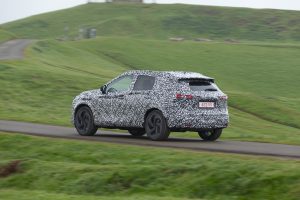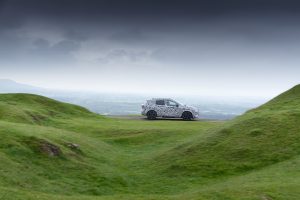CMF-C platform
The new Qashqai is the first new model in Europe to use the CMF-C platform, which represents a state-of-the-art automotive structure and technology architecture.
Central to the engineering concept was the desire to retain the current Qashqai’s proportions, which are “just right” and key to its success, meaning it comfortably navigates urban roads and fits nicely in parking spaces, while also giving excellent interior roominess.
In terms of construction, the body in white makes use of more lightweight material, as well as advanced stamping and welding techniques to increase strength but also reduce weight. For the first time, the rear hatchback door on the Qashqai is now made of a composite material, which saves 2.6kg.
 The use of Nissan’s Ultra High Strength Steel application (UHSS) has increased by 50 per cent in the structure of new Qashqai.
The use of Nissan’s Ultra High Strength Steel application (UHSS) has increased by 50 per cent in the structure of new Qashqai.
The front and rear doors, plus front wings and bonnet, are all now made of aluminium, which offers a weight saving, when taken all together, of 21kg.
The base structure – the “backbone” – of the CMF-C platform has been updated to a more homogenous shape, in order to better transmit an impact through the structure.
This will have the effect of the structure absorbing the energy more effectively in the crumple zones.
The net advantage for customers, thanks to the advanced manufacturing techniques, is that the overall body in white is lighter by 60kg and 41 per cent stiffer than the outgoing model.
This translates to refinement, ride comfort and driving response from a higher segment, plus exceptional security in the event of an accident – as well as having benefits to the car’s overall efficiency.
New suspension and steering design
The new Qashqai will continue to offer a rewarding driving experience – building on its reputation as a refined and cossetting drive, but nevertheless enjoyable when the road turns twisty.
Thanks to the CMF-C platform, the new Qashqai has an updated Macpherson strut set-up at the front and rear.
For two-wheel-drive Qashqais specified up to and including 19-inch wheels, rear suspension is a torsion beam configuration. For 20-inch wheels and all-wheel drive versions, it will be equipped with an advanced multi-link set-up.
The torsion beam installation offers improved bump absorption and road-noise suppression, resulting in a composed and quiet drive on all road surfaces.
 Key to its wide-ranging abilities is the change in spring and damper to a vertical alignment. This allows the spring and damper to work in their optimal stroke range, maximising their effectiveness for more controlled response to bumps and shocks in the road and to minimise rebound for a settled, composed ride, while maintaining excellent anti-roll performance through changes of direction.
Key to its wide-ranging abilities is the change in spring and damper to a vertical alignment. This allows the spring and damper to work in their optimal stroke range, maximising their effectiveness for more controlled response to bumps and shocks in the road and to minimise rebound for a settled, composed ride, while maintaining excellent anti-roll performance through changes of direction.
The advanced multi-link rear suspension configuration offers a best-in-segment balance between ride comfort and dynamic response. It is now mounted to the sub-frame by bushes, which reduce road noise and vibrations transmitted from the road.
The power steering set-up has been upgraded, offering improved response, better feeling around the central part of the steering range and reduced friction.
David Moss, Senior Vice President for Research and Development in Nissan’s Africa, Middle East, India, Europe and Oceania region, said: “Our engineering team has benchmarked a cross-section of C-segment hatchbacks, as well as direct competitor vehicles, and through thousands of kilometres of testing on roads and test facilities throughout Europe, have achieved a ride and handling balance which places driving pleasure at the heart of the experience.”
Innovation for efficiency
The new Qashqai stands within the wider Nissan electrification strategy and will offer customers two powertrain solutions – a flexible and efficient 1.3-litre petrol engine with mild hybrid technology, while Nissan’s innovative e-POWER electric motor driven system will bring the exciting instant and linear acceleration EV feeling to the Qashqai, without the range concerns.
With the more torsionally rigid body-in-white structure, the drive for optimal efficiency in the new Qashqai has been at the heart of the entire development process.
And that drive for efficiency extends to the use of the flexible 1.3-litre petrol engine which will be available in two power outputs, both combining responsive characteristics with frugality and low emissions.
The front styling of the car also generates an air curtain that directs the air flow around to reduce the drag generated by the front wheels.
 The 1.3-litre petrol engine has been extensively updated to include a mild hybrid system. The 12v system incorporates a separate lithium battery installation mounted under the floor and a belt-driven generator to harvest braking energy.
The 1.3-litre petrol engine has been extensively updated to include a mild hybrid system. The 12v system incorporates a separate lithium battery installation mounted under the floor and a belt-driven generator to harvest braking energy.
This allows the engine’s systems to run on harvested energy, extending the duration of the stop/start function which reduces the engine’s overall CO2 emissions. Additionally, it allows coasting and also offers torque support under acceleration.
e-POWER
The new Qashqai will represent the best of Nissan’s innovative spirit – otherwise known as Nissan Intelligent Mobility. It will bring the first deployment of Nissan’s innovative e‑POWER drive system to Europe.
e-POWER is comprised of a high-output battery and the powertrain which is integrated with petrol engine, power generator, inverter and a motor.
In conventional hybrid systems, the wheels are driven by an electric motor and a petrol engine. However, in the e-POWER system, the petrol engine is not connected to the wheels; it simply charges the battery.
And unlike a full EV, the power source is the engine, rather than just the battery.
The key difference compared with other conventional hybrids is that the electric motor is the size of one typically found in a pure EV, giving the instant acceleration response which is so popular among EV customers.
The engine-driven generator maintains the battery charge, but can also provide electricity directly to the motor for additional power. The engine operates at an optimal RPM range promoting maximum fuel efficiency while being carefully tuned to minimise noise and provide a natural, connected feel during hard acceleration.
For customers, e-POWER brings that distinctive instant and linear acceleration feeling, delivering a fun-to-drive experience but without the range anxiety.
David Moss said: “The advanced and efficient powertrain options represent Nissan’s innovative spirit – none more so than the e-POWER system. It brings all the benefits of an EV powertrain without compromise. When we talk about Nissan Intelligent Mobility, e‑POWER is a perfect example.”
Upgraded ProPILOT driver assistance
The new Qashqai will be equipped with the next generation of ProPILOT driver assistance, bringing greater driver support in a wider array of circumstances.
The system is able to resume automatically if the vehicle has been stationary for less than three seconds and the traffic in front of the car moves away.
The steering system and the camera are constantly updating the vehicle’s position, helping the car to stay centred within the lane while maintaining a pre-determined speed but with the capability to adapt and maintain a safe distance to the car in front.
On the all-new Nissan Qashqai, the updated system is now able to adapt the car’s speed according to additional external circumstances: when the car crosses to a lower speed limit zone on the highway, the system is able to read road signs and take into account navigation system speed limit data to slow the Qashqai to the appropriate speed, meaning the driver doesn’t need to adjust the cruise control speed manually.
The system can also use data from the navigation system to adjust the speed for approaching curves or exit ramps that have a tighter radius.
Furthermore, ProPILOT with Navi-link can now communicate with the Qashqai’s blind-spot radars to help intervene with a steering input correction to help prevent a lane-change manoeuvre if there is a vehicle in the blind-spot zone.
Other upgrades include a “flank protection” warning for urban situations, which alerts the driver of the risk of contact with an object on the side of the vehicle, typically when turning into a supermarket parking space.
And the new Qashqai can also intervene to prevent a collision upon reversing from the space thanks to an upgrade on the existing Moving Object Detection alert, applying the brakes to stop the car if a moving obstacle is detected nearby.
ProPILOT with Navi-link will be available from the mid-level N-Connecta grade to enable the majority of Qashqai drivers to enjoy this unique advanced technology, epitomising Nissan’s brand promise of “innovation for excitement”.
Marco Fioravanti, Vice President, Product Planning, Nissan Europe, said: “ProPILOT is one of our most appreciated innovations on the current Qashqai. Customers love how it seamlessly supports the driver in maintaining a smooth, precise and secure drive, particularly in busy traffic conditions, at night or in bad weather.
Intelligent LED headlights
The current Qashqai has been equipped with LED lights on upper grades since its launch in 2014, and those on the top-grade Tekna version swivel to follow the road in response to steering wheel inputs.
For the new Qashqai, Nissan’s engineers have developed an advanced headlight system that adapts the shape of the beam according to the road conditions and other road-users.
The beam is divided into 12 individual elements that selectively deactivate upon detection of an oncoming vehicle. Thanks to this innovation, it can project a brighter beam further and wider, but the shape effectively changes so oncoming road-users will not be dazzled.
Marco Fioravanti said: “The starting point for the design and development of the all-new Qashqai was a deep analysis of the relationships we’ve had with all of our Qashqai customers over the last 13 years.
“It has enabled us to understand their needs and, in particular, what they value in the crossover that they use and rely on daily.”
Read more: Nissan’s all-new Qashqai breaks cover



